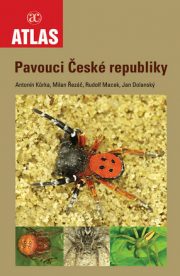Bibliografie
Řazení: Rok, Autoři / Autoři, Rok
2024
- Local and landscape factors affecting the biodiversity of spiders in temperate deciduous forest and forest-steppe ecosystems. Ph.D. theis, Mendel University, Brno, pp.
-
Hamřík T. (2024): Local and landscape factors affecting the biodiversity of spiders in temperate deciduous forest and forest-steppe ecosystems. Ph.D. theis, Mendel University, Brno, pp.

2023
- Effect of landscape structure depends on habitat type in shaping spider communities of a natural mosaic of Eurasian forest-steppe
-
Hamřík T., Gallé-Szpisjak N., Batáry P. & Gallé R. (2023): Effect of landscape structure depends on habitat type in shaping spider communities of a natural mosaic of Eurasian forest-steppe. Insect Conserv. Divers. 16 (4): 497–507. DOI: 10.1111/icad.12639

- Opening the canopy to restore spider biodiversity in protected oakwoods
-
Hamřík T., Košulič O., Gallé R., Gallé-Szpisjak N. & Hédl R. (2023): Opening the canopy to restore spider biodiversity in protected oakwoods. For. Ecol. Manag. 541 (121064): 1–14. DOI: 10.1016/j.foreco.2023.121064

- Effects of land use and climate on web-building spiders and their prey in dry dipterocarp forests
-
Michalko R., Hamřík T., Košilič O., Songsangchote C., Trisurat Y. & Birkhofer K. (2023): Effects of land use and climate on web-building spiders and their prey in dry dipterocarp forests. Forest Ecol. Manag. 546 (121366): 1–9. DOI: 10.1016/j.foreco.2023.121366

2022
- Pavouk 53 (12/2022)
-
Roušar A., Erhart J., Rückl K., Řezáč M., Gloríková N., Machač O., Mlčoch P., Petrov �., Pekár S., Hamřík T., Střeštík V. & Růžička V. (2022): Pavouk 53 (12/2022)

- Pavučenka dlouhovlasá po dlouhé době!
-
Machač O. & Hamřík T. (2022): Pavučenka dlouhovlasá po dlouhé době! Pavouk 53: 4 (in Czech)

- Sublethal and lethal effects of different residues of spinosad on Pardosa spiders.
-
Niedobová J., Ouředníčková J., Hamřík T., Mészárosz M. & Skalský M. (2022): Sublethal and lethal effects of different residues of spinosad on Pardosa spiders. Ann. Appl. Biol. 181 (2): 225–234. DOI: 10.1111/aab.12767

- Prosvětlování lesů jako návrat k tradičnímu výmladkovému hospodaření podporuje diverzitu epigeických druhů pavouků.
-
Vymazalová P., Košulič O., Hamřík T., Šipoš J. & Hédl R. (2022): Prosvětlování lesů jako návrat k tradičnímu výmladkovému hospodaření podporuje diverzitu epigeických druhů pavouků. Canopy thinnings as a return to the traditional coppicing supports the diversity of ground-dwelling spiders. Zprávy lesnického výzkumu 67 (2): 80–89 (in Czech, English abstract and summary)

2021
- Řízené vypalování jako efektivní ochranářský management pro podporu biodiverzity stepních stanovišť
-
Hamřík T. & Košulič O. (2021): Řízené vypalování jako efektivní ochranářský management pro podporu biodiverzity stepních stanovišť (Prescribed burning as an effective conservation management tool to support steppe habitat biodiversity). Ochr. přír. 76 (6): 17–21 (in Czech, English summary).

- Impact of small-scale conservation management methods on spider assemblages in xeric grassland
-
Hamřík T. & Košulič O. (2021): Impact of small-scale conservation management methods on spider assemblages in xeric grassland. Agricult. Ecosys. Environ. 307 (107225): 1–13. DOI: 10.1016/j.agee.2020.107225

- Positive impact of traditional coppicing restoration on biodiversity of ground-dwelling spiders in a protected lowland forest
-
Vymazalová P., Košulič O., Hamřík T., Šipoš J. & Hédl R. (2021): Positive impact of traditional coppicing restoration on biodiversity of ground-dwelling spiders in a protected lowland forest. Forest Ecol. Manag. 490 (119087): 1–10. DOI: 10.1016/j.foreco.2021.119084

2019
- Struktura a distribuce společenstev pavouků (Araneae) v závislosti na ochranářském managementu přírodní památky Pláně.
-
Hamřík T. (2019): Struktura a distribuce společenstev pavouků (Araneae) v závislosti na ochranářském managementu přírodní památky Pláně (Structure and distribution of spider communities (Araneae) depending on conservation management of Pláně Nature Monument). MSc. thesis, Mendel University, Brno, 82 pp. (in Czech, English abstract)

2018
2016
- Agrární terasy jako refugium xerotermních organismů – příklad z okolí Veverských Knínic.
-
Hamřík T. (2016): Agrární terasy jako refugium xerotermních organismů – příklad z okolí Veverských Knínic (Agrarian terraces as a refuge for xerothermic species of organisms – example from the surroundings of Veverské Knínice). BSc. thesis, Mendel University in Brno, 74 pp. (in Czech, English abstract).

Média
9.1.2024Prosvětlování porostů a výmladkové hospodaření (od 11:13)
| Link | www.mujrozhlas.cz |
|---|---|
| Autoři | Ing. Tomáš Hamřík |
18.12.2023Pařezení pomáhá pavoukům. Studie prokázala, že zastaralý způsob péče o les zlepšuje jeho rozmanitost
| Link | ct24.ceskatelevize.cz |
|---|---|
| Autoři | Ing. Ondřej Košulič, Ph.D., Ing. Tomáš Hamřík |
Statistiky
Nalezeno
140
Nálezy
67
Druhy
46
Rody
2
Čtverce
Určeno
108
Nálezy
45
Druhy
26
Rody
1
Čtverce


